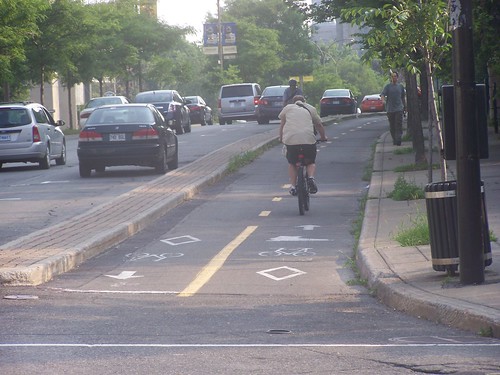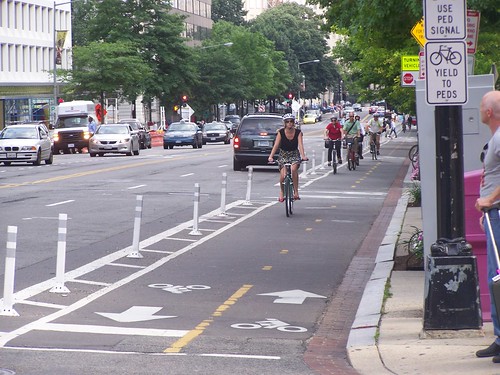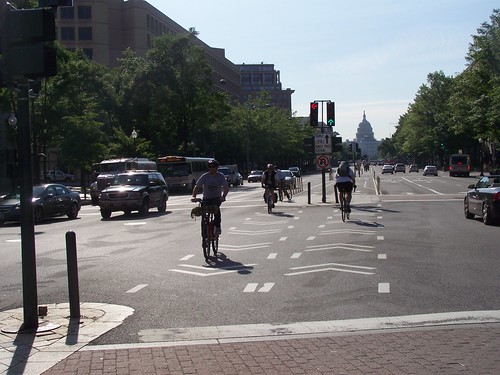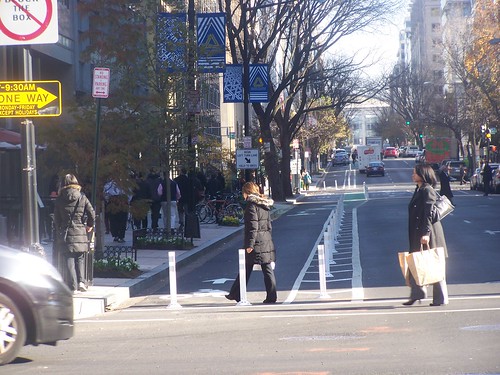Designing conflict in vs. designing conflict out: road design and the Pennsylvania Avenue bike lanes
The "Washington Area Bicyclist Association blog has a piece ("HOW MANY U-TURNS ACROSS PENNSYLVANIA AVE BIKE LANES DID WE COUNT IN ONE HOUR?") on the "U Turn" problem and the bike lanes in the middle of Pennsylvania Avenue and the conflict between motor vehicles and bicyclists.
The blog entry is nicely done, with video, and finds as many as 13 illegal U turns per hour on particular blocks.

1200 block of Pennsylvania Avenue NW, Google Street View, August 2007. Note that the street is wide and there is a large marked median in the middle of the street.
But the reality is that this is the result of a fundamental design problem and is to some extent, unfixable, because of how the lanes were placed in the street, the width of the street, driver expectations about where bike lanes are placed, and the inability to place (semi-)permanent bollards in the street for urban design reasons.
Sure you could do enforcement, but the need for enforcement is in turn an indicator of poor design. The reasons that I say that it is unfixable are (1) too many drivers on Pennsylvania Avenue are itinerant, so "education programs" won't have any effect and (2) most people, even knowing that the U turn is illegal, will think "just this once" justifies driving illegally, and will ignore the rule, not expecting that there could and would be any consequences to their action.

Cycle track (piste cyclable) in Montreal. Montreal, like many European cities, installs bi-directional separated cycle tracks, figuring that if they don't make them bi-directional, people will ride in both directions anyway.
The 15th Street cycle track is bi-directional, but is placed on just one side of the street.

The point I make about planning is that it is supposed to "design conflict out" rather than to create it.
But Pennsylvania Avenue is a very very wide street, with comparatively low traffic volumes, but had a "median" in the street, empty unused space--except for occasional parking by emergency vehicles, that was seemingly easy to convert to bike lanes.
The DC transportation department did the conversion in response to a challenge issued by Congressman Earl Blumenaur at a public presentation by David Byrne, author of the Bicycle Diaries--at least that's what I seem to remember, it might have just been a NACTO event. Congressman Blumenaur said, "it would be so easy, do it."
If the suggestion had been by someone less prominent in sustainable transportation circles, the idea would have been more rigorously evaluated, which, if had it been done, would probably have determined that it would have been better to put one bike lane in each direction, in the right lane on each side of the street. Or baring that, a separated bi-directional cycletrack on either or both sides of the street.
The bike lanes on Pennsylvania Avenue NW are in the middle of the street, which is outside of expected or recommended design and engineering practice.

Sure, bike lanes on the side of the street would have posed some conflicts and problems too, but comparable to any issues that come up with cycletracks, such as the one on L Street NW.
Instead, not being able to install bollards for urban design reasons, motor vehicles will continue to make U turns, and because they don't expect cyclists in the middle of the road, this will continue to create problems.
L Street NW, between 11th Street and 24th Street, is one way in the eastbound direction. A uni- or single direction cycletrack has been installed on the left side of the street. (Maybe it should have been installed on the right, but I believe the idea was that there would be fewer conflicts between motor vehicles and cyclists in this particular configuration.)

Alternative treatment, bike lanes on the sidewalk. One of the commenters on the blog who usually is "Anonymous," recommends doing what is done in Germany and other countries in Northern Europe, where bike lanes are placed "on the sidewalk" between the walking zone for pedestrians and the road/curb.
In this photo, near the Hamburg train station in Germany, you can see the bike lane on the rightmost side of the photo. Were this treatment done on Pennsylvania Avenue NW, I would have recommended a "road diet" for the Avenue, and taking out one lane in each direction, and the sidewalk could have been extended with an on-sidewalk bike path installed, comparable to this treatment.
Note that even though "I knew" that the red pavers denoted the bike zone, I frequently walked in this zone, errantly. (There weren't all that many cyclists in the part of Hamburg that I was habituating.)

Another alternative, equally expensive, and not likely to be approved by design review authorities (the National Capital Planning Commission and the Commission on Fine Arts) would be retractable bollards. They would be heavy and would prevent cars from making U turns, but the city could argue that they would not be permanent structures marring the viewshed.
Labels: "streets as places", bicycle and pedestrian planning, civil engineering, street design, sustainable transportation, traffic engineering, traffic safety and enforcement, urban design/placemaking



8 Comments:
BRILLIANT- again thi sproves that you, Richard- are at the forefront in planning and bicycle innovation on this side of the drink !!!
Again, this is DC specific, but what I dislike about the PaAve lanes is they are in the sun. No shade from street trees.
Yes, a sidewalk bike lane (on both sides) would work better.
Would also work on L St, although there are a lot of curb cuts. Nobody apparently bothered to see the number of deliveries on L.
Two way would have been preferable on L as well. Granted the idea was the M st lane was the other way.
The lights and lane arrangements are superior on the M st lanes. The road condition on M is unusable.
Good point about the sun. I hate to admit I haven't ridden on the M St. cycletrack yet.
your comment about pavement quality also pertains to 15th St. The stretch from P St. to U St. is abominable.
The funny thing about bi-directional... I had always thought that one way made the most sense. For one, it's a lot easier to deal with signals.
But at the ThinkBike workshop led by people from the Netherlands in the Fall of 2010, they took the idea of bi-directional as a matter of course, saying people will ride both ways regardless.
http://urbanplacesandspaces.blogspot.com/2010/11/dutch-thinkbike-project-in-dc.html
(wow, this piece reads really well today also.)
At that meeting, David Patten (he plans in Arlington but lives in DC) and I proposed a cycle track on M St. from the Met Branch to and across the Key Bridge, connecting a bunch of trails in the process (CCT, Met Branch, Rock Creek, etc.). We called it the Cross-Town Trail but we didn't come up with specialized signage, e.g., like
http://josephprichard.com/projects/better-bikeways-project/
"The stretch from P St. to U St. is abominable."
That has been redone, much improved.
The L st track is wide enough -- they took out an entire traffic lane. IN fact they narrowed the track because it looks so much like a lane. Signals would be a major pain. Curb cuts as well --very hard to get out of garage on L st right now between road and bike and pedestrain traffic.
when my bike comes back from major overhaul (5 years has finally destroyed the sprocket and gearing mechanisms), I'll venture out and check these lanes out once again.
I don't know. A cycletrack on Penn had been in the works since the 2005 bike plan, so I'm not sure how much Earl influenced it. That has been the story batted around (even by me), but I think that has been overstated. Earl had been including it in speeches for quite a while so it could have been anyone of many events where you heard him mention it. By the time of the "Cities, Bicycles, and the Future of Getting Around" panel discussion, he's already been talking about it for some time. [That discussion was in December of 2009 and the designs were released in March 2010, so it's unlikely that DDOT could turn that around that fast]
http://greatergreaterwashington.org/post/4345/just-put-on-a-coat-already-cyclists-in-a-strange-land/
Less than a week later Gabe Klein stated that they had been working on it for some time.
http://www.thewashcycle.com/2009/12/gabe-klein-chat-2-smartbike-parking-and-pa-ave-bike-lanes.html
I think Klein had way more to do with it than Earl.
But I think the cycletrack was always going to be in the center. The thing is it was going to have flex posts and be painted green, but that was shot down by the CFA. They were also going to be in the innermost lanes instead of the median, but that changed at the last minute. I don't think that hitting the pause button for a year or two would have changed the basic design at all.
Also, one nice thing about having a facility in the sun is that snow and ice melt better, and it's warmer in the winter.
Buy
Cenforce 100 mg Online,it contains Sildenafil Citrate. Male suffering from
pulmonary arterial hypertension or erectile dysfunction can try Sildenfil Citrate. Sildenafil
100mg tablets On Best Prices USA today. Order for Sildenafil Citrate Tablet and
treat ED.
Doze Pharmacy
Anti fungal
Anthelmintics & Anti-Worm
Isotroin
20mg Capsule (Isotretinoin)
Nublexa 40mg
Tablet (Regorafenib)
Nizonide
500mg Tablet (Nitazoxanide)
Mebex 100mg
Tablet (Mebendazole)
Imatib 400mg
Tablet (Imatinib)
Zocon 150mg
Tablet (Fluconazole)
Post a Comment
<< Home